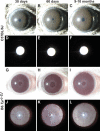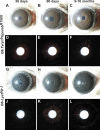Microarray analysis of iris gene expression in mice with mutations influencing pigmentation
- PMID: 20739468
- PMCID: PMC3053276
- DOI: 10.1167/iovs.10-5479
Microarray analysis of iris gene expression in mice with mutations influencing pigmentation
Abstract
Purpose: Several ocular diseases involve the iris, notably including oculocutaneous albinism, pigment dispersion syndrome, and exfoliation syndrome. To screen for candidate genes that may contribute to the pathogenesis of these diseases, genome-wide iris gene expression patterns were comparatively analyzed from mouse models of these conditions.
Methods: Iris samples from albino mice with a Tyr mutation, pigment dispersion-prone mice with Tyrp1 and Gpnmb mutations, and mice resembling exfoliation syndrome with a Lyst mutation were compared with samples from wild-type mice. All mice were strain (C57BL/6J), age (60 days old), and sex (female) matched. Microarrays were used to compare transcriptional profiles, and differentially expressed transcripts were described by functional annotation clustering using DAVID Bioinformatics Resources. Quantitative real-time PCR was performed to validate a subset of identified changes.
Results: Compared with wild-type C57BL/6J mice, each disease context exhibited a large number of statistically significant changes in gene expression, including 685 transcripts differentially expressed in albino irides, 403 in pigment dispersion-prone irides, and 460 in exfoliative-like irides.
Conclusions: Functional annotation clusterings were particularly striking among the overrepresented genes, with albino and pigment dispersion-prone irides both exhibiting overall evidence of crystallin-mediated stress responses. Exfoliative-like irides from mice with a Lyst mutation showed overall evidence of involvement of genes that influence immune system processes, lytic vacuoles, and lysosomes. These findings have several biologically relevant implications, particularly with respect to secondary forms of glaucoma, and represent a useful resource as a hypothesis-generating dataset.
Figures


References
-
- Oetting WS, Fryer JP, Shriram S, King RA. Oculocutaneous albinism type 1: the last 100 years. Pigment Cell Res. 2003;16:307–311 - PubMed
-
- Ray K, Chaki M, Sengupta M. Tyrosinase and ocular diseases: some novel thoughts on the molecular basis of oculocutaneous albinism type 1. Prog Retin Eye Res. 2007;26:323–358 - PubMed
Publication types
MeSH terms
Substances
Grants and funding
LinkOut - more resources
Full Text Sources
Molecular Biology Databases

